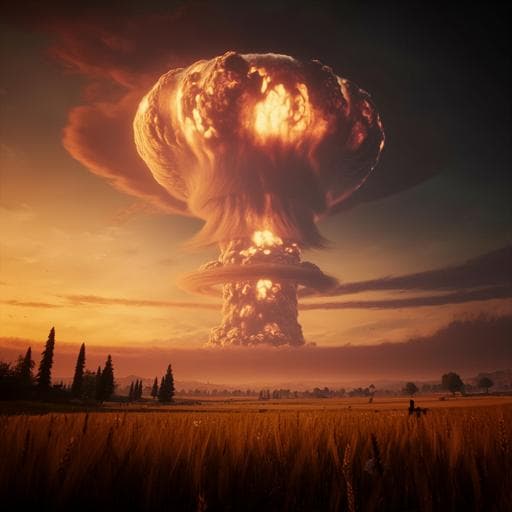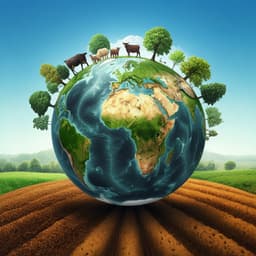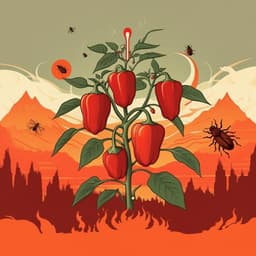
Environmental Studies and Forestry
Global food insecurity and famine from reduced crop, marine fishery and livestock production due to climate disruption from nuclear war soot injection
L. Xia, A. Robock, et al.
This research explores the catastrophic impacts of nuclear weapon-induced atmospheric soot on global food production, revealing a grim outcome: over 2 billion lives at risk from a conflict between India and Pakistan, and more than 5 billion from a war between the United States and Russia. Conducted by prominent authors such as Lili Xia and Alan Robock, this study underscores the urgent need for global cooperation to prevent nuclear war.
~3 min • Beginner • English
Introduction
The study investigates how climate disruptions caused by soot injected into the stratosphere from urban firestorms in nuclear wars would affect global food security. Historical analogs such as volcanic eruptions (e.g., Laki 1783, Tambora 1815) show that sudden cooling can trigger severe famines and instability. Modern nuclear arsenals could loft 5–47 Tg of soot in regional conflicts (e.g., India–Pakistan) and over 150 Tg in a large-scale US–Russia war, inducing multi-year to decadal global cooling and reduced sunlight. Previous work examined agricultural and fisheries impacts separately or for limited regions; an integrated, global assessment combining land crops and marine fisheries across a wide range of soot scenarios has been lacking. This study addresses that gap by estimating national-level, post-war calorie availability after stored food is consumed, under assumptions about halted trade and potential societal responses regarding livestock and fisheries.
Literature Review
Earlier research on nuclear winter and volcanic cooling established that stratospheric aerosols can cause significant, prolonged global cooling and disrupt monsoons, leading to agricultural crises. Foundational nuclear winter studies from the 1980s examined prospective agricultural and societal impacts, but were limited by data and model capabilities at the time. Recent studies quantified impacts on major grains and marine wild-capture fisheries for regional nuclear conflict scenarios, suggesting severe but variable regional outcomes. Observations from recent large wildfires (Canada 2017; Australia 2019–2020) demonstrated that smoke can self-loft into the stratosphere and persist globally, supporting the physical basis for modeled soot behavior. However, prior work did not comprehensively integrate both terrestrial crops and marine fisheries across a full spectrum of soot loadings and did not quantify national-level calorie availability under different societal responses, which this paper advances.
Methodology
Six nuclear war scenarios were defined by stratospheric soot injections of 5, 16, 27, 37, 47, and 150 Tg, representing a one-week war with specified numbers and yields of weapons and urban targeting. Climate forcing was simulated using the Community Earth System Model with the Whole Atmosphere Community Climate Model (CESM/WACCM), at ~2° atmospheric/land and 1° ocean resolution. Soot was injected during the week starting 15 May of Year 1. Output variables (2 m air temperature, precipitation, direct and diffuse solar radiation, sea surface temperature, and ocean net primary productivity) drove impact models. No bias correction was applied; raw model output was used to allow variance changes.
- Crops: The CLM5crop model simulated maize, rice, soybean, and spring wheat (winter wheat assumed to respond like spring wheat), with separate rainfed/irrigated components (assuming no freshwater limitation), and included grass carbon for pasture estimation. Calibration and validation were against FAO yield data (1991–2010 spatial patterns; 2006–2018 time series).
- Fisheries: The BOATS model simulated size-structured biomass and fish catch, driven by CESM sea surface temperature and net primary productivity, with a bioeconomic component for fishing effort. Inland fisheries were excluded (7% of total fish).
- Food system integration: National calorie availability combined simulated crops and marine wild-catch with FAO Food/Commodity Balance Sheets (2010). Total plant-based production changes applied the average reduction of the four simulated crops. Livestock and aquaculture production were assumed proportional to feed availability (livestock: ~46% pasture, 54% crop-based feed; aquaculture: crop-based feed). Grass leaf carbon informed pasture changes. Direct climate impacts on livestock/aquaculture physiology were not modeled.
- Trade and responses: International food trade was set to zero by applying the ratio of domestic production to domestic supply for each commodity, reflecting likely export restrictions. Three societal response scenarios were analyzed: (1) Livestock (maintain livestock/aquaculture; business-as-usual fishing), (2) No Livestock (livestock/aquaculture not maintained after Year 1; a fraction of livestock grain feed diverted to humans; fivefold fish price to increase fishing), and (3) Partial Livestock (50% of livestock grain feed diverted to humans; remaining feed used to raise livestock). Fractions of diverted feed were explored (0–100%), with 50% presented in main tables.
- Food waste and biofuels: Household food waste (baseline ~20%) sensitivity included 50% and 100% reductions becoming available as food. Only final biofuel products (biodiesel/ethanol-equivalent calories) were added back (byproducts already counted in feed/waste flows). Stored food was assumed consumed in Year 1; analysis focuses on Year 2.
- Calorie thresholds: National outcomes were evaluated relative to two levels: calories to maintain normal physical activity and the basal metabolic rate (resting energy expenditure). A threshold of 1,911 kcal per capita per day was used for survival-level maintenance in global aggregation. National maps assumed equal within-country distribution of available calories.
Key Findings
- Climate shocks: Cropland-average surface solar radiation declined by ~10 W m−2 (5 Tg) up to ~130 W m−2 (150 Tg); maximum 2 m air temperature reductions peaked at ~1.5 °C (5 Tg) to ~14.8 °C (150 Tg) within 1–2 years, persisting >10 years; ocean cooling and light loss were smaller due to heat capacity and hemispheric smoke distribution.
- Crop production: Global average calorie production from maize, rice, wheat, and soy decreased ~7% (5 Tg, Years 1–5), up to ~50% (47 Tg), and ~90% at Years 3–4 in the 150 Tg scenario—exceeding historical FAO anomalies even at 7%.
- Marine wild-capture fisheries: Reductions were smaller than crops, reflecting moderate ocean NPP declines (~3% at 5 Tg to ~37% at 150 Tg) and less pronounced ocean cooling. Nevertheless, fisheries contribute a small share of calories (~0.5%) but ~3.5% of global protein.
- Combined food supply: Terrestrial crops dominate total calorie changes (crop production ~24× fisheries by dry matter; staple crops ~5× fish caloric density per retail mass).
- National disparities: Mid- to high-latitude countries (e.g., China, Russia, United States, France, North Korea, United Kingdom) face 30–86% calorie reductions in a 27 Tg scenario, while lower latitudes (India, Pakistan, Israel) see <10% from indirect climate effects. However, direct war impacts in belligerents (contamination, infrastructure loss) are not included here.
- Mortality risk estimates (Table 1, Year 2, no trade, Partial Livestock 50%):
• 5 Tg: 27 million direct fatalities; 255 million without food.
• 16 Tg: 52 million direct; 926 million without food.
• 27 Tg: 97 million direct; 1.426 billion without food.
• 37 Tg: 127 million direct; 2.081 billion without food.
• 47 Tg: 164 million direct; 2.512 billion without food.
• 150 Tg: 360 million direct; 5.341 billion without food (5.081 billion if all household waste is added).
- Global calorie availability (Year 2, no trade): Under Livestock, global changes are −8.2% (5 Tg), −23.8% (16 Tg), −33.4% (27 Tg), −42.1% (37 Tg), −49.2% (47 Tg), and −81.3% (150 Tg). Under Partial Livestock (50% feed to humans): +13.5%, −5.7%, −17.4%, −28.1%, −36.7%, and −77.1% respectively. No Livestock (50% feed to humans): +5.9%, −12.1%, −22.9%, −32.9%, −40.8%, −79.0%.
- Distribution sensitivity: With equitable global distribution and reduced household waste, sufficient global calories could persist for smaller soot cases (e.g., 5 Tg with baseline waste; 16 Tg with 50% waste reduction; 27 Tg with no waste). Even with optimistic assumptions (100% livestock feed to humans, no waste, equitable distribution), 47 Tg could barely support survival-level calories globally.
- Country cases: Australia and New Zealand fare comparatively better in 150 Tg due to modeled spring wheat responses and crop mix, though refugee inflows and within-country inequities could strain supplies. Major exporters (Russia, United States) exhibit severe declines, heightening risk of export restrictions.
- Overall: Livestock/aquatic foods cannot offset climate-driven crop losses beyond the smallest soot scenarios; adaptation via waste reduction has limited effect under larger soot loadings.
Discussion
The integrated modeling indicates that nuclear-war soot-induced climate perturbations would severely curtail global food production, with crops hardest hit, and fisheries offering little caloric compensation. Under common crisis behaviors (export bans, maintaining livestock), many nations, especially at mid-to-high latitudes, would experience calorie availability below maintenance needs, risking widespread famine. Reallocating livestock feed to humans and reducing household waste can mitigate deficits for small-to-moderate soot injections, but effects are insufficient for larger scenarios. The analysis underscores the vulnerability of import-dependent regions (notably parts of Africa and the Middle East) to export restrictions and trade collapse. Even with theoretically optimal global redistribution, logistical, political, and equity challenges would impede effective mitigation. The findings substantiate long-standing warnings that nuclear war would be globally catastrophic for food security, aligning with the principle that a nuclear war cannot be won and must never be fought.
Conclusion
By combining state-of-the-art climate, crop, and fisheries models with national food system accounting, the study quantifies how nuclear-war soot injections (5–150 Tg) would translate into national calorie availability in Year 2 post-war. It shows that even a 5 Tg scenario causes unprecedented global crop anomalies, and larger scenarios produce multi-year collapses in food supply, with livestock and fisheries unable to compensate. Under plausible no-trade assumptions, more than 2 billion people could die from an India–Pakistan war and over 5 billion from a US–Russia war. Policy implications include the critical need for nuclear conflict prevention and international cooperation to avoid escalation. Future research should explore rapid adaptation strategies (alternative foods requiring little light/heat, protected cultivation, crop switching), economic and logistical dimensions of trade and distribution under crisis, multi-model ensembles for crops and fisheries, and additional stressors (UV radiation, pests, radioactive contamination, resource constraints).
Limitations
- Modeling scope: One Earth system model (CESM/WACCM), one crop model (CLM5crop), and one fisheries model (BOATS); limited ensembles beyond the 5 Tg case. Biases and structural uncertainties remain despite model fidelity in prior comparisons.
- Crop processes: No explicit treatment of surface ozone, enhanced UV radiation, pollinator/pest dynamics, killing frosts, or seed availability; winter wheat approximated by spring wheat response; irrigation assumes no freshwater limitation.
- Livestock/aquaculture: Assumed proportional to feed availability; direct physiological climate impacts not modeled; inland fisheries excluded (7% of fish production).
- Socioeconomic assumptions: International trade set to zero by a simple domestic production/supply ratio; equal within-country food distribution assumed; no dynamic population changes (mortality, fertility), labor constraints, or infrastructure/fuel/fertilizer shortages incorporated; food loss from harvesting not considered.
- Timing/storage: Stored food assumed consumed in Year 1; rationing and storage management could alter Year 2 outcomes.
- Equity and logistics: National-scale FAO data mask subnational disparities; equitable global redistribution deemed challenging but not explicitly modeled with economic/trade systems.
Related Publications
Explore these studies to deepen your understanding of the subject.







